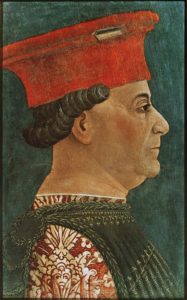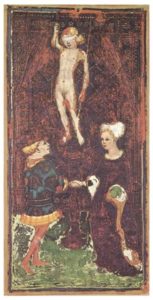This is the first of a three-part post on the process used to paint the earliest extant tarot cards (about tarot), made in fifteenth-century northern Italy. Part I: The Studio | Part II: Preparing and designing the tarot cards | Part III: Painting and gilding the tarot cards
An art studio of the fifteenth century would have been pleasant place to work—or hell on earth, depending on the master’s temperament, and tidy—or chaotic, again depending on the master’s temperament.
Materials of all kinds would have to be on hand: to name a few, wooden panels in various stages of preparation; minever tails for brushes, preserved in a slurry of chalk or clay; minerals and clays for primers and paints, bought from a chemist who compounded medicine as well; feather quills, the kind of bird according to the kind of brush or pen to be made; inks and charcoal for drawing; parchment and paper for sketching.
The studio itself would have windows to let in air and the good light of the sun. Still, the artist worked constantly immersed in the fumes of thinners, animal glue, and the various pigments (many of them toxic) used to make paint and varnishes. Fumes weren’t the only danger. Artists often “sharpened” their brushes with their lips, constantly ingesting lead, used for white, among other minerals.

Fresco painting, of course, was not done in a studio, but on site. The work would have been physically exhausting. Painting ceilings demanded that the arms be lifted over one’s head or body, and artists were constantly climbing on and off scaffolding which might be very high, for example, in the dome of a church. Despite occupational hazards, artists often outlived their more hard-living patrons. Bonifacio Bembo, for example, outlived two dukes of Milan, including Francesco Sforza, who may have commissioned Bonifacio to make tarocchi cards.
Depending on the studio and the work to be done, an artwork would be executed by master and apprentices, or by a single artist. The work would take several stages from preparation of the medium to the actual painting and decoration.
A commission for tarocchi cards would have provided a pleasant diversion from more demanding works. Cennino d’Andrea Cennini’s circa 1437 Il Libro dell’ Arte described how to paint and gild on panel. The techniques for painting and guilding cardboard would have been much the same.
About Tarot: While many consider tarot cards “New Age,” the earliest extant decks originated in late medieval Northern Italy, and were used in a game like bridge. The 78 cards of a traditional tarot deck comprise suits (now called Minor Arcana) and trumps (now called Major Arcana). The 56 suit cards resemble modern playing cards, with four suits, each with ten “pips” and a court of king, queen, male knight (jack) plus a female knight. The 22 trump cards feature allegorical figures such as Fortune, Temperance, the Sun, and the Moon. No one knows the source of the original designs and structure of the tarot, made distinct from other playing cards by its set of triomphi (later called Major Arcana). The earliest known written reference to the triomphi as a set of cards dates from 1440, around when the earliest extant tarocchi decks were made. (back to top)
RENAISSANCE ITALY: GLORY, BEAUTY, GREED, WAR.
A POWERFUL HOLY WOMAN. THE INQUISITION….
A novel based on the true story of the Popess card of the tarot.
BUY: Signed by author, free shipping in US
BUY: bookshop.org | Amazon US | Amazon CA | B&N | indiebound
“Enchanting & richly historical, heart-wrenching & intoxicating.” —Stuart R. Kaplan, author Pamela Colman Smith.
“A storytelling treasure. The sights, smells, feel of Renaissance Italy seep from every pore of the story.” —Ron Andre, A Matter of Fancy
SOURCES: Visconti-Sforza “Lovers” via Wikipedia Collection of Pierpont Morgan Library and Museum | Francesco Sforza via Wikipedia Collection of Pinacoteca di Brera, Milan | Cennini: The Craftsman’s Handbook. Translated by Daniel V. Thompson, Jr. New York: Dover, 1954.


Pingback:Early tarot artists at work | Part III Painting and gilding
Pingback:Early tarot artists at work | Part II Preparing and designing the cards